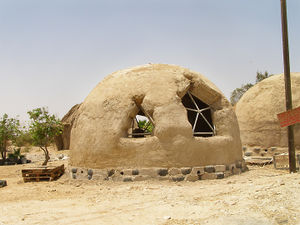
A Kibbutz is a micro-economy and organization of peoples based on community. The first of these settlements was founded in what would eventually become the State of Israel in 1909, more than 40 years before statehood. According to History of Kibbutz, the number has skyrocketed to nearly 300. In a way similar to what many would consider socialism, the Kibbutz is about mutual welfare. Members do jobs as necessary, depending on the common export of the Kibbutz, or simple agricultural needs and have their individual needs met by the community. However, unlike a communist state, most Kibbutzim operate governmentally as democracies. While a handful of elected, full-time officials make daily decisions, all its members formulate policy, elect officers, authorize the kibbutz budget and approve new members.[1]
The Kibbutz is considered a desired life to many, with there even being agencies that can organize temporary placement. One such is Kibbutz Program Center. It's a simple life, where living off the land becomes more than a tag-line attached to any conversation about a weekend camping trip.
Green Movement[edit | edit source]
By 1996, Green Kibbutz Group National Movement, Israel enlisted seven communities into making the Kibbutz a more environmentally sustainable unit.
An article published in New Renaissance Magazine spoke of one Kibbutz in particular, Samar, and their "Sunergy Project, an ambitious idea of harvesting all their electrical needs directly from the sun, using photovoltaics, and hooking into the national grid as a battery."[2] Kibbutz Lotan, one of the preeminent green Kibbutzim, offers a 5-month program to live and work on the Kibbutz through Kibbutz Program Center where participants would, according to the program's page, work on:
- Local food production
- Permaculture
- Ecological design techniques
- Natural/alternative building
- Sustainable technologies – composting toilets, grey and black water purification systems, solar ovens, geodesic domes
- Community Design
- Environmental ethics
The Future[edit | edit source]
The popularizing of travel helps this type of life persevere through times when one may guess it would struggle. In Aug., 2010, The Guardian published an article questioning it's future. The article said that the Kibbutz was more than a socialist community, but a Zionist project.[3] The writer also goes on to support the claim that the communities are largely secular, stating that only 16 identify themselves as religious.
However, the Kibbutz has gone private. Approximately 60 of the nearly 300 Kibbutz in operation today exist in a merely communal manner. Most have introduced different wages and privatized some of the services in an effort to turn profits and stave off the large-scale debts the communities were falling into.[4]
An article published in Haaretz, one of Israel's most popular newspapers, told of how the first Kibbutz, Degania, was forced to privatize and pay it's members different salaries in accordance with market expectations in 2004.[5] The image of the Kibbutz has been fundamentally changed.
"The romantic tale from the beginning of the previous century, of a young Hebrew pioneer who goes out with the flock to the pasture, or plants a tree on the slope of the mountain, was eventually replaced by a high-tech agriculture that combines advanced science and technology.
The modern farmer is an organization man, who on the one hand operates 21st-century equipment with the help of agricultural R&D (which is a leader in global agriculture), and on the other hand, on the ground is busy transporting... the Thai workers!"
An excerpt from "Shnot Kibbutz: Sipura shel Hatnuah Hakibbutzit" -(100 Years of Kibbutz: The Story of the Kibbutz Movement) by: Eliezer Sachs
External links[edit | edit source]
- Child of the Collective — Guardian Article
- Kibbutz Program Center — Several different work-study and volunteer opportunities
- Israel re-brands Kibbutzim to lure eco-aware generation — Guardian Article
- Passport to the World